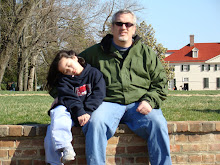By Kevin Huizenga.
Published by Drawn and Quarterly, Montreal.
Copyright 2006.
145 pages
Drawn and Quarterly is an outfit you can count on for off beat comic books, and this one fits the bill. I admire the authors ambitiousness, but frankly it's a tad boring and difficult to get through. The ideas and narratives are so convoluted and academic it's difficult to read. And I read a lot, so I am not so easily confounded. I almost gave up in the middle of the first story. So for those who think that comics are for dummies, I challenge them to try this one on for size. There is some nice poetry in the merger between images and context. One of the more memorable stories is about how excited he gets when he gets those advertisements in the mail that have the missing children information. He goes into length describing them and explaining what his interest in them are. Then, inexplicably, he ties them to the Lost Boy of Africa from Sudan.
And this 'novel' is actually a book of short stories. Many of them have a fantastical or spiritual bent to them, which made it harder for me to read. I tend to like grittier and more realistic stories. When stories start to get into the realm of fancifulness, I star to lose interest.
Here are some of the topics of the stories:
1) During researching the topic of visions, the narrator starts to have some visions which scare him and then midway he tells the tale of an 18th century ghost tale in which a man has visions. He never really ties in the first part to the second part of the story.
Here's a quote to demonstrate just how difficult the language really is.
"You sir, know my tract on 'The cardinal Functions of the Brain.' There, by evidence of innumerable facts, I prove the high probability of a circulation arterial and venous in its mechanism, through the nerves."
And that is actually one of the easier ones to understand. I must confess, on rereading parts of this book while I write, the prose is a bit more understandable, but not much.
2)The story about the missing children mentioned above.
3) A story about how he and his wife have tried everything possible way to conceive a child. Finally he tries to find a feathered ogre, which if he gains the ogre's feather, all problems would be resolved. It is based on a folktale, but it gets silly. Even some of the conversation is silly.
4) A discussion of how the birds Starlings came to America and the history of that bird. Perhaps one of the more interesting excerpts from the book.
5) The exact text of adoption papers describing the child's circumstances contrasted to some Asian style landscapes. An interesting study of contrasting the profound and the profane.
6) An odd story in which the majority is spent on some friends that get together at a restaurant and we get to hear snippets of their conversations. This story is booked mark by some inexplicable scenes in which they are in a grave yard, for no apparent reason and in the middle there is a bike ride by the author and his wife in which winds are whipped up... and then nothing is made of that. One of the most confounding stories of the whole book.
7) A very short story on "The Hot New Thing" in which the history of this thing is shown even with out ever saying what that thing actually was. In other words, these new fads and such seem to repeat the histories of old fads, so the Hot New Thing could be described in such a generic manner.
8) And finally, a story about a conservative evangelical who is writing a paper in which he defends the traditional Hell in which sinners experience eternal suffering against his more progressive peers who have a more humane version of Hell. They believe that Hell is Eternal in that you are eternally dead, but not that a person necessarily suffers for eternity.
As I reread parts of this, I can appreciate the book better. This is therefore a book that needs to be reread and even discussed to appreciate it better... if one can find the motivation to do so.
And finally, one cant talk about a graphic novel with out talking about the illustrations. His style is very simple which contrasts his herky jerky story telling style. He does like to use bold and thick lines which help his creatures look a little more spooky. The stories in back, which are in full color, tend to lose this boldness of line, so perhaps these are later drawings. While easier on the eye, they do seem less dramatic.
Here is a much more eloquent review of the same book. You can also see the illustrations. He likes the book much more than I . I also like his comment about the drawings of suburbia.
And another discussion by a professional - A Librarian!
Wednesday, July 28, 2010
Subscribe to:
Post Comments (Atom)




No comments:
Post a Comment